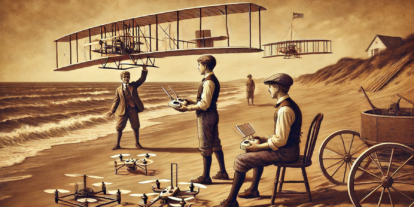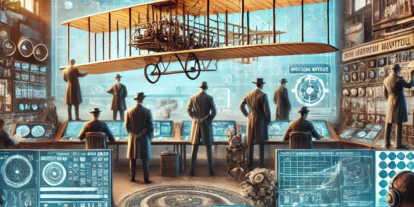With Fourth of July weekend right around the corner, many UAS enthusiasts may be drawn to taking their drone to the skies to capture photos and videos of the celebratory firework shows. With this in mind, I’d like to share some of the potential risks operating during a firework show can pose for you as the drone pilot in command and to others. Whether you are a seasoned commercial drone operator or a new recreational flyer, I hope the following information provides insight on how to keep yourself, your equipment, and others in the NAS safe this Independence Day.
1. Night Operational Risks
With firework shows taking place after civil twilight during night time hours, many additional risks must be taken into account if you plan to operate a UAS. In April 2021, the FAA released the revised Unmanned Aircraft General (UAG) airman knowledge test to include revisions of 14 CFR part 107 and a new 14 CFR part 89 information on operations over people, remote identification, and night operations. This free test includes detailed information about the challenges of flying at night including night illusions and physiology. Learn more about the UAG test here.
One common night illusion UAS pilots experience is night blind spots which is the loss of sharpness, color, depth perception, and judgement of size in the center of your field of vision at night. Night blind spots can be heightened by looking at bright lights or flashes such as those emitted by a firework exploding in the sky. Many firework shows take place over open bodies of water like lakes, rivers, and the ocean. The reflection of the water in combination with sporadic emittance of light from the fireworks can result in difficulty in keeping visual line of sight of your drone’s anti-collision light. These are just two examples of the potential night illusions a drone operator could experience during a firework show. Watch this video to learn more about operating a UAS at night and other potential operational risks.
2. Environmental Hazards and Restrictions
Firework shows draw excited crowds of people ready to celebrate America’s birthday, therefore in order to fly your drone during a firework show you may need to have sustained flight over large groups of people. In effect as of April 2021, the FAA’s final rule on Operations of Unmanned Aircraft Systems Over People states your operation must meet the requirements of category 1, 2, or 3 to be eligible to operate over people. Read more about the categories and the FAA’s rule on operations over people here.
To summarize, to compliantly sustain flight over people under category 1, 2, or 3 your drone can not contain any exposed rotating parts that could lacerate human skin upon impact with a human being. Most quadcopters on the consumer market today do have exposed rotors which could lacerate human skin upon impact. This means to maintain FAA compliance for drone operations during firework shows over large crowds of people, you would need to purchase propeller guards or like accessories in addition to following the other requirements in the final rule.
In addition to following FAA requirements in your operational area, you should take into account that firework shows emit loud noises that often disrupt the normal behavior of many species of wildlife. Spooked aviary wildlife could pose a serious danger to a hovering drone in the night sky. In addition to risk of bird strike to your drone, fireworks produce ash and debris which rains down from the sky. These tiny particles could easily be sucked into your drones propellers causing a variety of mechanical and technological issues in your equipment.
3. Airspace Restrictions
Due to large groups of people gathering for these firework shows, some local ordinances enact Temporary Flight Restrictions (TFRs) for the airspace surrounding the city or county the firework display will take place in. As always, make sure to check your airspace on the B4UFLY or Aloft app to check for TFRs or any other airspace advisories which may prohibit you from operating at your intended location. Learn more about how to safely and compliantly operate a drone at night in controlled and uncontrolled airspace here.
If your airspace is clear to take off and you feel confident in your night operation abilities, it is highly recommended to have one or more visual observers (VO) assist you in your operation. This way you will have additional eyes on the skies scanning for potential unseen obstructions and obstacles.
As you have read, there are many unique risks in operating a drone at night during a firework show on the Fourth of July. Instead of flying a drone to capture photos and videos of firework shows, across the US, drone light shows are replacing often dangerous fireworks completely as the holiday’s entertainment. Colorado drone light show company, Hire UAV Pro is providing a festive alternative to firework shows in areas where wildfire risks are a major concern. Their drone light shows can use upwards of 1,000 drones that fly in formation in a constant location across the sky. Watch one of Hire UAV Pro’s light shows here.
If you are a commercial drone pilot, consider looking into offering drone light shows as a service for holiday festivities. We hope you found this information helpful to keep you, your drone and others safe this Fourth of July. From the entire Aloft team, we wish you a safe and happy Independence Day!
Erica Cooley
Erica Cooley is Aloft’s Head of Community, she’s responsible for connecting with the expanding drone community to provide educational opportunities on how to leverage technology to fly with compliance and safety. Erica is an FAA-certified Part 107 Remote Pilot since 2017. Her passion for gender and diversity inclusion in the UAS industry is demonstrated as a proud member of Women and Drones & a brand ambassador for Women Who Drone. She is also an FAA Safety Team Representative in the Seattle, WA area. Erica received her BA from the University of Puget Sound in Communication Studies.



